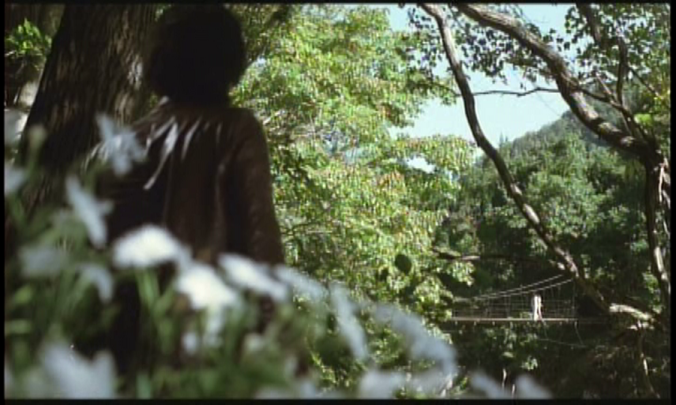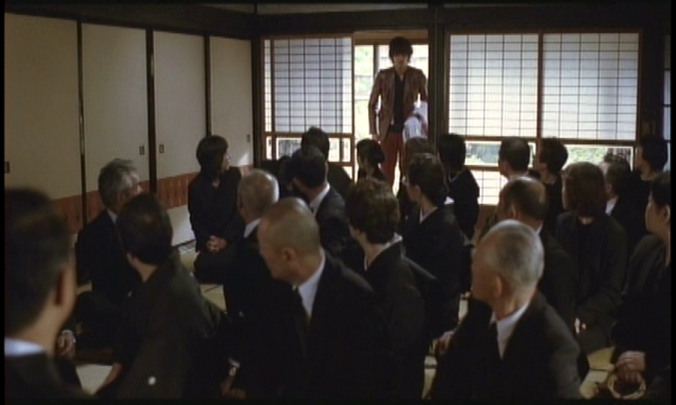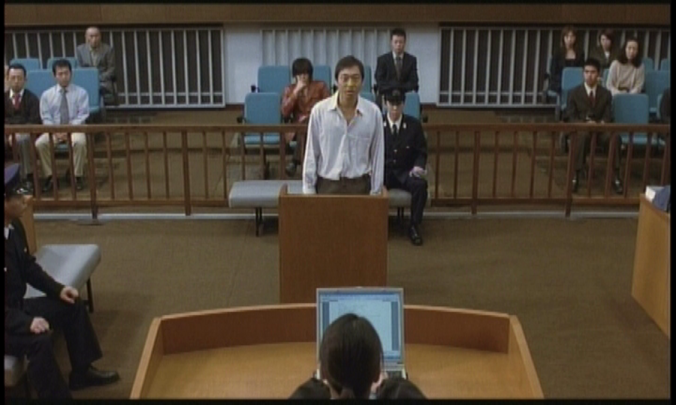 One of the most persistent aspects of Japanese movies is that a plot summary does not often tell you what the movie is like or even what it is about. That is especially true of Miwa Nishikawa’s Sway.
One of the most persistent aspects of Japanese movies is that a plot summary does not often tell you what the movie is like or even what it is about. That is especially true of Miwa Nishikawa’s Sway.
In summary, the plot seems simple. Two brothers go to visit an old holiday spot along a river with a woman who is romantically connected to both. In the course of the trip, she goes off of an old swaying bridge. Did she jump, did she fall, or was she pushed? Though we spend considerable time in the courtroom, that is not the real subject of the film.
Takeru, the younger brother, has left home while the elder brother Minoru has stayed home to work in the family business. Takeru has forged a successful career as a photographer in Tokyo and dresses the part, with leather jacket, beard, and tight pants. He comes home for the observation of the first anniversary of his mother’s death too late to change into his suit, gets in an argument with his tyrannical father, and leaves again, ending up in the bed of Chieko, the old girlfriend left behind when he ran away ten years earlier. Chieko now works at the family gas station and everyone assumes that she will marry Minoru, though he has never actually made a proposal. The next morning, they all go to the river where Takeru wanders away across the bridge to take photographs. Minoru is afraid of heights, but when Chieko starts across the bridge and seems to hesitate as if to jump, he goes out after her. When he grabs her, she pulls away, and the next thing we know, she is gone. The brothers call the police and everyone agrees it was an accident, until Minoru is questioned about an altercation with a rowdy customer, at which point he says it was all his fault and the police charge him with murder. Takeru says he saw nothing.
He comes home for the observation of the first anniversary of his mother’s death too late to change into his suit, gets in an argument with his tyrannical father, and leaves again, ending up in the bed of Chieko, the old girlfriend left behind when he ran away ten years earlier. Chieko now works at the family gas station and everyone assumes that she will marry Minoru, though he has never actually made a proposal. The next morning, they all go to the river where Takeru wanders away across the bridge to take photographs. Minoru is afraid of heights, but when Chieko starts across the bridge and seems to hesitate as if to jump, he goes out after her. When he grabs her, she pulls away, and the next thing we know, she is gone. The brothers call the police and everyone agrees it was an accident, until Minoru is questioned about an altercation with a rowdy customer, at which point he says it was all his fault and the police charge him with murder. Takeru says he saw nothing.
At this point, we enter the courtroom where Minoru slowly modifies his original story, and then Takeru also changes his story, saying he did witness the event after all, leading Minoru to be sent to prison. But we’re not in Rashomon territory with people telling the story to make themselves look good. Nor do we ever know for sure what actually happened. Seven years later when Minoru has finished his sentence, Takeru has a new vision which adds more detail but which may or may not be true, since it is spurred by old 8mm film of the kids’ trip to the same river. Whether true or not, it spurs him to go look for Minoru on the day he is released.
The tie between brothers is the real subject of the movie. Takeru has essentially broken all ties to anyone but his dead mother. Joe Odagiri, with his unruly hair and smart-aleck car (a Ford Fairlane stationwagon), is the essence of the boy who ran away from conventional life, while Teruyuki Kagawa as Minoru is the essence of the man who wants to be normal, similar to the character in Tokyo Sonata that made him famous in the west. There are hints that he too would have preferred to break away from the father, but he has long since given up hope of that. Minoru is the elder brother, which means he has responsibilities that Takeru could never have, and he also felt responsibility for his mother, since he has become quite skilled at calming situations down.
Father is inordinately proud of the legacy that he will leave of a business built from nothing, but that business is just one single gas station, which to American eyes seems like barely enough to live on, not the great domain father believes it to be. The gas station itself is unusual, because no pumps are visible and the hoses all drop down from the roof.
As with so many Japanese films, motivations are hinted but never explained. The Japanese title sometimes is translated as “tremble” or as “waver,” either of which meanings fit the story a bit better. Everything wavers in the plot, far more than any visible sway on the bridge. Teraku says he has changed his story because he thinks Minoru is lying and he wants his honest brother back. Why Chieko went on the bridge is a mystery – we must assume that she has finally made a choice to go with Teraku, though Teraku sees her as only a one night stand. Nor do we really know why Minoru went on the bridge, for he is deeply afraid of heights and can only move with both hands clutching the wire railing. Nor do we know why he grabbed her, causing her to pull away to get away from him and to fall to the bridge floor before disappearing through a gap in the railings. Nor do we know about Minoru’s feelings for Chieko – everyone just assumes they will get married because she is 29 and needs to get married. Only much later in the film do we realize that he knows Chieko slept with Teraku, but neither jealousy nor anger about this are reflected in what we see on the bridge. Minoru seems to be absolutely serious in his concern for Chieko’s safety.
The court scenes remind us of how different the Japanese justice system is from the American system. There are three judges and no jury, and prosecutor and defense never disagree about what may or may not be admissible. Though Teraku is a witness, he is present inside the courtroom at all times.The trial is merely to establish the details so that a proper sentence can be determined.  Minoru doesn’t deny his confession but modifies it to add detail around the circumstances, to say the fall itself was an accident, though he still admits to causing the fall but not to actually pushing her over the edge.
Minoru doesn’t deny his confession but modifies it to add detail around the circumstances, to say the fall itself was an accident, though he still admits to causing the fall but not to actually pushing her over the edge.
There are times when it seems to be a period film. After all, the station wagon is forty years old and Takeru takes his photos with a Leica and a Hasselblad, though admittedly these continued to be preferred by many professionals. But in the courtroom, the stenographer uses a laptop. It is an original script by Nishikawa, so there is no reason to think that it was based on an autobiographical novel.
Fascinating as the film is while watching, it still leaves us unsure of everything. Only Minoru’s hint of a smile when he at last hears Teraku calling him suggests a reconciliation, but it is only a suggestion.


Pingback: K-20: The Fiend with Twenty Faces / K-20: Kaijin niju menso den (2008) | Japanonfilm